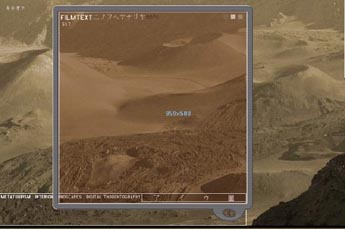 |
Mark America |
One of my favourite images of the becoming-second-nature of digital literacy, concerns the story of the San Francisco lawyer addicted to playing the computer game Myst, “The only problem was when I began clicking on things in real life. I’d see a manhole cover and think, ‘Hmmm, that looks pretty interesting’, and my forefinger would start to twitch”. At this moment of unconscious, involuntary action, our lawyer manifests the precept that everything in the world is data and everything is connectible. To live in the world is not enough. One must now make the world a database (DB). The image of wandering through the street, processing information into new, unpredictable relations is the paradigm of an emergent way of living in the world. Digital literacy and hypertextual consciousness are some of the names given to this new sensibility. If we were able to ask our lawyer to describe his view of the world, he would probably respond by saying, This is what it feels like to be a wireless apparatus…a streaming consciousness always on the avant-go.
Conceptual art Ebook-happening in site-specific performance environment with literary figures nomadically wandering through an open field of relational aesthetics. Or: composing a network. That’s as good a way of describing Filmtext (2001), Mark Amerika’s most recent experiment in net art, coming on the heels of his influential Grammatron (1993-1997) and Phon:e:me (1999)—as any. Commissioned by PlayStation. Exhibited as part of Amerika’s 2001 retrospective at the ICA in London, Filmtext is ostensibly a game-space, an online story world based on the premise, what might it be like living in a post-apocalyptic desert of the real. The mise en scene of this world is a rather arid landscape of dormant volcanos that act as interfaces or portals into an alternative way of looking at and sensing this apparently barren world. As with most computer-based games, there are levels to be moved through, subject to the achievement of competencies and the completion of tasks. The fundamental logic or literacy of all computer games—seek, find and use—becomes a conceptual logic of understanding, a forging of wholes out of the relation of parts. As we move through the levels as meta-tourists, we quickly realise that we are in fact riders (to use William Gibson’s term), digital hitchhikers, vicariously streaming consciousness through someone else’s point of view. It may be, for all we know, that San Francisco lawyer. But we learn that he has a name. He is the Digital Thoughtographer. He is a desert apparition, a trace, an incipient identity only glimpsed in silhouette.
Surf-sample-manipulate. In using the idea of an ambient game-space to track the movements of a nomadic alien life-form, Amerika has inventively elevated the computer game to the level of a performative manual of DIY electronic subject formation. Instead of scoring points, play at becoming a network, a data-sphere, or a cyborg. In Filmtext, Amerika re-defines Claude Levi-Strauss’ notion of the bricoleur for the digital age. Amerika’s Digital Thoughtographer is a composite of listener, reader, user, finder, seeker, jack-of-all-trades. A nomadic figure who wanders through the contemporary media-scape and makes do with whatever is at hand in the name of literacy, he/she also brings the shadow of other media, of other ways of conceiving the world through media, of conceiving the world as media. Far removed from the static eye of Renaissance optics, the Digital Thoughtographer is reminiscent of the ‘kino eye’ of Dziga Vertov’s Man With A Movie Camera; the peripatetic flaneur of Charles Baudelaire and Arthur Rimbaud; the jump-cut-edit-as-you-go aesthetic of Jean Luc Godard, and the reality media of anyone who can get their hands on a digital camera and some editing software. Rather than being overwhelmed by a bombardment of disconnected information, the Digital Thoughtographer creates new forms of meaning, new gestalts forged out of the logic of relational aesthetics. Consciousness, artistic composition, even the humble art of reviewing, can be redefined as digital remix.
Expanding the concept of writing. Mark Amerika has variously described his work as “unclassifiable writing” or “literature’s exit strategy.” In his work we find the concept of writing pushed to extremes. As an alien life-form, the Digital Thoughtographer stands for writing as it was imagined in classical times. That is, that which is from afar, inhuman, yet capable of altering what it means to be human. As “techne”, an art for ordering the world into meaning, it converges with our current media and in the process transforms them. The last thing one could call Amerika is an apologist for post-literacy, since his work represents an active demonstration of what writing might look like as it transcends the printed page. Not restricted to the word, writing now includes time-based media, animation and the database. In this, Filmtext is a compelling response to the calls from philosophers such as Jacques Derrida to put into practice an integrated audio-visual-pictographic writing. In combining the language of film and inscription, Filmtext is an expression of our ‘post-literate’ culture.
Filmtext, Mark Amerika, E-media Gallery, Centre for Contemporary Photography, Melbourne April 14-May 4
Prefiguring Cyberculture: An Intellectual History, eds Darren Tofts, Annemarie Jonson, Alessio Cavallaro, will be published October 2002 by Power Publications and MIT Press.
RealTime issue #49 June-July 2002 pg. 20
© Darren Tofts; for permission to reproduce apply to [email protected]








 back
back